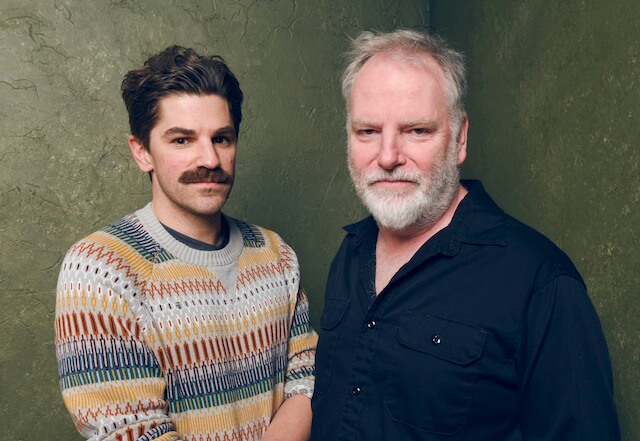Guy Maddin tends to cram his retro-style films — like “Careful,” “The Saddest Music in the World” and “My Winnipeg” — silly with stuff: gags, old movie styles, anxieties. His latest, “The Forbidden Room,” directed with new co-conspirator Evan Johnson, is even more busy. It crams a dozen-plus stories — about submarines, caves, doubles, zeppelins and Udo Kier doing brain surgery — into over two hours, told in a nesting doll structure that keeps unfolding, segueing from one story to the next, then back again a la the Polish classic “The Saragossa Manuscript.” With many of these, the inspiration was a lost film that Maddin and Johnson reimagined their own absurdist way. There was so much they’re even spilling threads and bits that didn’t make the final cut into a web series, called “Seances.” Maddin and Johnson spoke at some length with Metro during the film’s stint at the New York Film Festival, just before its American theatrical release. I didn’t, unfortunately, research this, but the Sparks song in the movie: is that an already existing song? Guy Maddin: No, they wrote that for us. We had this film from Greece called “Fist of a Cripple.” We wanted to have as many genres in the movie, to give the viewers a chance to keep track of what stratum they’re on. We thought “Fist of a Cripple” could be edited into a musical number, music video-style. We tried a number of previously existing songs. We tried making sound sculptures, but none of us are songwriters. But I am friends of Ron and Russell Mael of Sparks, so we just hit some bullet points for them that they had to hit with their lyrics. And within a few hours they had written a song, recorded it and delivered it to us. We all love the song, it’s catchy as hell, but we debated if it belonged in this universe, because it’s so clean and poppy. Then we realized this movie has a kitchen sink, for crying out loud. Can’t it have a Sparks song too? It does make the universe of the film seem more expansive. Maddin: It says, “Hey, we’re allowed to do whatever we want now.”
RELATED: “The Forbidden Room” brings back the Guy Maddin craziness I got the impression that some of these ideas were ones you had lying around for years, waiting to be crammed into one of your films. Maddin: It’s certainly not beneath us. My very first movie, which was about my dream relationship with my dead father [called “The Dead Father”], maybe got re-used in a subplot about a dream about a dead mustache. Evan Johnson: These feelings you were accessing you were re-using. We’re always recycling the same traumas.
Maddin: I’ll take anything from anywhere. We had plans to shoot even more. Thank god they were aborted. We’d still be in the editing room. And we’re still in the editing room for the companion piece, “Seances.” The notebook I keep on all these films recycles lots of things, not only from things I’ve already made but things from my family. I’m sure every filmmaker has a notebook of things they intend to jam in somewhere. There have been a number of things I wrote down very early that I’ve only jammed in in recent years. Sometimes I even shoot something but it will fall off, because it wasn’t meant to be jammed into that picture. Finally it’s like, “OK, cross that off the notebook.” The nesting doll structure is a convenient way to jam in lots of stories that might not have much narrative connection. How did you come up with that idea?
Johnson: I had been a fan of Raymond Roussel, who’s a real nester, story-wise. My favorite was called “Documents to Serve as an Outline.” There’s dozens of narratives, and they’re very short, nesting into one another. Maddin: Some are only half a sentence long.
Johnson: A murderer goes to see a play and the play tells the story of a man who sees images in a cloud, and the cloud tells a story — so on and so forth. It’s 10 or 12 layers deep, concisely written. Part of it for us was the challenge of making stories fit into a narrative that you couldn’t necessarily follow but would feel like one feature film. That meant playing with tone, atmosphere and emotional or erotic rhythms over the course of a full film but which are occurring through many stories. Maddin: And blobbing the nest together to form a facsimile of a three-act structure. One nesting is the first act, which has a more energetic and inviting shtick to each one. Then the second one is more leisurely and perambulating. And the third is the darkest one. Then there’s a kind of splooge of climaxes. And then it’s over and they have to mop up the theater. I was actually reminded of Brian De Palma’s “Raising Cain,” which has a 20, 30 minute stretch where people keep waking up from dreams, then finding themselves in other dreams — just to mess with the audience. Maddin: You never remember going into the dream, but you remember coming out. It’s the coming out of the nesting that I like the most, the pulling out. I’ve always been a quitter. Pulling out offers me the most sublime satisfaction in these nestings. It’s the un-nesting. Not the penetrating into the narrative depths, but just pulling out and going, “Ahhhhhhh.” There’s also “The Saragossa Manuscript,” which keeps digging deeper into stories.
Maddin: I love the idea of “The Saragossa Manuscript” and I respect and I always watch it with a respect. But it isn’t much fun. I’m not going to say anything bad about it, because I did know I was making a movie structured like that. I had to convince myself that our movie is somehow different. And it is, because the entirety of “Saragossa Manuscript” is shot using the same film stock, it’s got characters from the same time period, and war and a costumed and decorated world. That was enough for me, that we’re different enough. Each one of our narratives has a different palate and a different set of characters, who are all concerned with things that point in the same direction. As disparate as they might be, the stories have a singular motive force. We’re the mediums for them. There was a longer cut when “The Forbidden Room” debuted at Sundance, which I haven’t seen. Johnson: You wouldn’t notice the difference, maybe.
Maddin: If you thought of [this cut] as two yards of fabric, that one would be two yards and four inches of the same fabric.
Are there any plans to make it available later on? Maddin: I don’t see why we would. It just needed tightening. It was really great to have the advantage of previewing it at Sundance with a kind of f—ed up DCP. That gave us this Mulligan, a do-over, because the soundtracks on the DCP were out of synch with each other. It was a nightmare. I felt the movie didn’t get its premiere there. We went back and tightened it up because it was too long even for me, and now it’s the right length. We could have tightened it up until it was a brisk 75 minutes long. But it was important that people feel — and this is where it got tricky, because it wasn’t about making it as economical as possible. We wanted people to feel washed-up on a shore after barely surviving a tempest of narratives — floating around, wondering if they were going to survive or drown. We wanted people to be left panting on a shore after. RELATED: NYFF review: Chantal Akerman’s swan song, “No Home Movie” The script was partially created by taking lost films and reworking scenarios you only read about. Can you describe the writing process? Johnson: There were three of us in a room [the other being Robert Kotyk]. We had research material, we had the title of a lost film or a synopsis from a lost film. We would find things, a story that made us laugh, and just start to think about things. Maddin: Sometimes the title alone created a likely scenario. Sometimes you didn’t even have a synopsis. The Mikio Naruse lost film — we called them “losties” —which was “The Strength of a Mustache,” there was no synopsis. Evan knew that some Japanese films of that period dealt with a son’s shame on account of his father. So we started playing that, and it evolved into a dream about inheriting a dead father’s mustache. But sometimes we just had a title. And we would go about almost like a psychic who’s helping police solve a crime, or a bloodhound getting one whiff of something then heading off in a direction. One Naruse we almost used, and would have used had this project kept going, was called “Ladies, Beware of Your Sleeves.” These titles are amazing. We really liked the American lost serial “Ten Scars Make the Man.” What about shooting in those very different styles, which still feel more you than a mere pastiche?
Maddin: We knew early on that we weren’t going to imitate directors’ styles. It was suggested to us, “Well, you’re shooting a lost Von Sternberg movie. You make it look like Von Sternberg!” Only Von Sternberg knows to make a Von Sternberg movie. They’re some of the richest frames ever committed from light to emulsion. I couldn’t do it. And then I didn’t know enough about early Naruse to pay the same attention to imitation. We quickly realized we were the mediums through which these films would come. They would be in our voice. That meant our own mise-en-scene, our own two-bit set budget. The budget was a deliriously happy limitation. I don’t want to have too much money to spend on a set. I’ve had it once. On “The Saddest Music in the World,” I had 3.5 million dollars, in 2003, so that’s even more now. We had these big sets. Then I realized at the end of the movie I didn’t even shoot them. [Laughs] We put people in tiny corners and shot a close-up of them. I didn’t know what to do with big sets. But they looked great in the production designer’s scrapbook. Though perhaps a big set was at least inspirational even if you weren’t filming it in wide shots.
Johnson: Von Stroheim would actually, if he had wide shots with a tiny caviar dish buried in it, they had to be real caviar. It set the mood.
Maddin: We set the mood by having a cardboard silhouette flapping in a breeze. That’s our mood.
RELATED: NYFF reviews: Steven Spielberg’s “Bridge of Spies” and Michael Moore’s “Where to Invade Next” You shot this on digital, and it’s far easier now to mess with digital images to make them really look like beat-up film. What did the rushes look like? Maddin: Suicidally depressing for me.
Johnson: I pointed out one day, dispiriting you and our cinematographer, that they looked like a Chumbawamba video.
Maddin: That’s exactly what they looked like. I was pretty down in the dumps. I didn’t have my mojo. I spent too many years in a comfy groove shooting on film, with a camera that had a light leak, which is sort of like having your own personal color corrector, sprinkling pixie dust on your film. But my film camera broke shortly before I switched to digital. Color digital was grim, raw and untreated. Evan cavalierly assured me everything would be fine, that he knew exactly how to fix it. He didn’t, he was just bulls—ing me to calm me down, because he knew it was important I had some sassitude while filming, some confidence. It certainly wasn’t coming from the images I was seeing. But he made good on his promise, on his lie, that he would make it look as interesting as he did. He and Galen, his brother, they cooked up some recipes, some palettes, which pleases me to no end. Shooting on film creates all kinds of happy accidents. With digital you often have to create your own accidents, as it were.
Maddin: That’s the way Evan puts it. He’s created a situation where accidents can happen again. I was despairing because I felt with digital there were no accidents left. And I need happy accidents. Follow Matt Prigge on Twitter @mattprigge
Guy Maddin and Evan Johnson on ‘The Forbidden Room’ and that Sparks song

Getty Images














